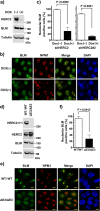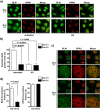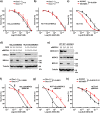HERC2 inactivation abrogates nucleolar localization of RecQ helicases BLM and WRN
- PMID: 33432007
- PMCID: PMC7801386
- DOI: 10.1038/s41598-020-79715-y
HERC2 inactivation abrogates nucleolar localization of RecQ helicases BLM and WRN
Abstract
The nucleolus is a nuclear structure composed of ribosomal DNA (rDNA), and functions as a site for rRNA synthesis and processing. The rDNA is guanine-rich and prone to form G-quadruplex (G4), a secondary structure of DNA. We have recently found that HERC2, an HECT ubiquitin ligase, promotes BLM and WRN RecQ DNA helicases to resolve the G4 structure. Here, we report the role of HERC2 in the regulation of nucleolar localization of the helicases. Furthermore, HERC2 inactivation enhances the effects of CX-5461, an inhibitor of RNA polymerase I (Pol I)-mediated transcription of rRNA with an intrinsic G4-stabilizing activity. HERC2 depletion or homozygous deletion of the C-terminal HECT domain of HERC2 prevented the nucleolar localization of BLM and WRN, and inhibited relocalization of BLM to replication stress-induced nuclear RPA foci. HERC2 colocalized with fibrillarin and Pol I subunit RPA194, both of which are required for rRNA transcription. The HERC2 dysfunction enhanced the suppression of pre-rRNA transcription by CX-5461. These results suggest the effect of HERC2 status on the functions of BLM and WRN on rRNA transcription in the nucleolus. Since HERC2 is downregulated in numerous cancers, this effect may be clinically relevant considering the beneficial effects of CX-5461 in cancer treatments.
Conflict of interest statement
The authors declare no competing interests.
Figures






Similar articles
-
HERC2 Facilitates BLM and WRN Helicase Complex Interaction with RPA to Suppress G-Quadruplex DNA.Cancer Res. 2018 Nov 15;78(22):6371-6385. doi: 10.1158/0008-5472.CAN-18-1877. Epub 2018 Oct 2. Cancer Res. 2018. PMID: 30279242
-
Expression and localization of Werner syndrome protein is modulated by SIRT1 and PML.Mech Ageing Dev. 2007 Nov-Dec;128(11-12):650-61. doi: 10.1016/j.mad.2007.09.004. Epub 2007 Oct 2. Mech Ageing Dev. 2007. PMID: 17996922
-
BLM helicase facilitates RNA polymerase I-mediated ribosomal RNA transcription.Hum Mol Genet. 2012 Mar 1;21(5):1172-83. doi: 10.1093/hmg/ddr545. Epub 2011 Nov 21. Hum Mol Genet. 2012. PMID: 22106380 Free PMC article.
-
Human RecQ helicases in transcription-associated stress management: bridging the gap between DNA and RNA metabolism.Biol Chem. 2021 Feb 11;402(5):617-636. doi: 10.1515/hsz-2020-0324. Print 2021 Apr 27. Biol Chem. 2021. PMID: 33567180 Review.
-
Structural mechanisms of human RecQ helicases WRN and BLM.Front Genet. 2014 Oct 29;5:366. doi: 10.3389/fgene.2014.00366. eCollection 2014. Front Genet. 2014. PMID: 25400656 Free PMC article. Review.
Cited by
-
MUT-7 Provides Molecular Insight into the Werner Syndrome Exonuclease.Cells. 2021 Dec 8;10(12):3457. doi: 10.3390/cells10123457. Cells. 2021. PMID: 34943966 Free PMC article. Review.
-
Harnessing the Nucleolar DNA Damage Response in Cancer Therapy.Genes (Basel). 2021 Jul 28;12(8):1156. doi: 10.3390/genes12081156. Genes (Basel). 2021. PMID: 34440328 Free PMC article. Review.
-
The G-quadruplex ligand CX-5461: an innovative candidate for disease treatment.J Transl Med. 2025 Apr 18;23(1):457. doi: 10.1186/s12967-025-06473-8. J Transl Med. 2025. PMID: 40251554 Free PMC article. Review.
-
Crosstalk between G-quadruplex and ROS.Cell Death Dis. 2023 Jan 18;14(1):37. doi: 10.1038/s41419-023-05562-0. Cell Death Dis. 2023. PMID: 36653351 Free PMC article. Review.
-
G-quadruplex DNA: a novel target for drug design.Cell Mol Life Sci. 2021 Oct;78(19-20):6557-6583. doi: 10.1007/s00018-021-03921-8. Epub 2021 Aug 30. Cell Mol Life Sci. 2021. PMID: 34459951 Free PMC article. Review.
References
Publication types
MeSH terms
Substances
LinkOut - more resources
Full Text Sources
Other Literature Sources

